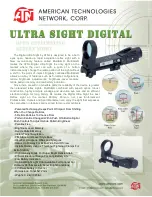
D
epending on the type of telescope
mount that you possess, there are two
ways in which you can move the instru-
ment in order to locate and track objects in
the sky. I stress ‘track’ here since, unlike
viewing stationary terrestrial objects, the rota-
tion of the Earth on it’s axis once in 24 hours
from west to east causes the sky to make one
revolution about the celestial poles in the
same period (incidentally, if you have not yet
familiarised yourself with the ‘Get to know the
sky’ section of this booklet, now might be a
good time to familiarise yourself with some of
the concepts contained within it).
The Alt-azimuth mount: this is the the sim-
plest type of telescope mounting to under-
stand and, in some senses, to use. There are
variations that I’ll discuss in a moment, but all
share the common characteristic that there
are two axes about which the telescope can
be moved which are perpendicular to one
another (see Fig.1, page 10). The first axis
permits the telescope tube to be moved from
horizontal to vertical and is known as the ‘alti-
tude’ axis. the second allows the instrument
to be moved in an arc parallel to the horizon
through a complete 360° circuit of the com-
pass; this is the ‘azimuth’ axis. So, a mount-
ing permitting motion about both such axes is
called an ‘alt-azimuth’.
In its most basic form (as provided with the
A s t rolux, Lunar- C a d e t 1, Merc u ry-607 &
Mercury-707) there is usually a ‘slow-motion’
control in the form of a threaded rod that is
operated by a thumbwheel permitting precise
control of the telescope’s tube in altitude. On
more sophisticated mounts (such as provided
with the Capricorn 70-2 and the Evostar 90-3)
there is provision for slow motion controls in
both altitude and azimuth — this makes for
much finer control when tracking celestial
objects at high power.
Alt-azimuth conventions: As has been dis-
cussed elsewhere, looking up at the night sky
gives the impression that the observer is at
the centre of a vast hemisphere — the so-
called ‘Celestial Sphere’. The stars, Moon and
planets all appear to lie on the inside surface
of this hemisphere an infinite distance from
the observer. This is, of course, an illusion
since the Moon and stars are in reality at
g reatly differing distances away from us.
However, the Celestial Sphere concept has its
advantages in that it makes it easy to define
coordinates for objects in the sky and to pre-
dict where a given star or planet will be at any
given time.
Looking at Fig. 1 once more, note that the
portion of the Celestial Sphere shown in the
diagram has been divided up by lines and arcs
in much the same way as the surface of the
Earth has been divided up into latitude and
longitude. By careful observation you will
note that the star Polaris which resides in the
constellation of Ursa Minor (the Little Bear)
always appears stationary above the northern
horizon at an angle very close to that of the
observer’s latitude. This is because Polaris is
very close to the northern celestial pole and
all the other stars appear to circle around it in
a counter-clockwise direction once every 24
hours. Lying close to due north means that
Polaris will always have an Azimuth bearing
close to zero, or 0°. For an observer in the
British Isles its Altitude bearing will lie
between 50˚ and 55°.
8
Using your telescop e ...






































